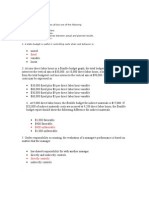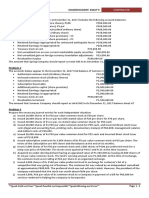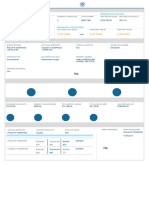Module-A211-12
Uploaded by
Arabela VillanuevaModule-A211-12
Uploaded by
Arabela VillanuevaWEEK 12
RESPONSIBILITY ACCOUNTING AND BUDGETARY CONTROL
Study objectives:
1. Describe the concept of budgetary control.
2. Evaluate the usefulness of static budget reports.
3. Explain the development of flexible budgets and the usefulness of flexible budget
reports.
4. Describe the concept of responsibility accounting.
5. Indicate the features of responsibility reports for cost centers.
6. Identify the content of responsibility reports for profit centers.
7. Explain the basis and formula used in evaluating performance in investment
centers.
8. Explain the difference between ROI and residual income.
Budgetary Control
The use of budgets in controlling operations is known as budgetary control. Such
control takes place by means of budget reports that compare actual results with planned
objectives. The budget reports provide management with feedback on operations.
Budgetary control involves:
a. Developing budgets.
b. Analyzing the differences between actual and budgeted results.
c. Taking corrective action.
d. Modifying future plans, if necessary.
Budgetary control works best when a company has a formalized reporting system. The
system should
a. Identify the name of the budget report such as the sales budget or the
manufacturing overhead budget.
a. State the frequency of the report such as weekly, or monthly.
b. Specify the purpose of the report.
c. Indicate the primary recipient(s) of the report.
Static Budget Reports
A static budget does not modify or adjust data regardless of changes in activity during
the year. As a result, actual results are always compared with the budget data at the
activity level used in developing the master budget.
A static budget is appropriate in evaluating a manager’s effectiveness in controlling costs
when (a) the actual level of activity closely approximates the master budget activity level,
and/or (b) the behavior of the costs in response to changes in activity is fixed.
Flexible Budgets
A flexible budget projects budget data for various levels of activity. The flexible budget
recognizes that the budgetary process is more useful if it is adaptable to changed
operating conditions. This type of budget permits a comparison of actual and planned
results at the level of activity actually achieved.
To develop the flexible budget, the following steps are taken:
a. Identify the activity index and the relevant range of activity.
b. Identify the variable costs, and determine the budgeted variable cost per unit of
activity for each cost.
ACCTG 211: Strategic Cost Management
SOUTH EAST ASIAN INSTITUTE OF TECHNOLOGY, INC. Page 1 of 5
c. Identify the fixed costs, and determine the budgeted amount for each cost.
d. Prepare the budget for selected increments of activity within the relevant range.
For manufacturing overhead costs, the activity index is usually the same as the index
used in developing the predetermined overhead rate; that is, direct labor hours or
machine hours. For selling and administrative expenses, the activity index usually is
sales or net sales.
The following formula may be used to determine total budgeted costs at any level of
activity:
Total budgeted costs = Fixed costs + (Total variable cost per unit X activity level)
Total budgeted costs at each level of activity can be shown graphically.
a. In a graph, the activity index is shown on the horizontal axis and costs are shown
on the vertical axis.
a. The total budgeted costs for each level of activity are then identified from the total
budgeted cost line.
Flexible budget reports are another type of internal report produced by managerial
accounting. The flexible budget report consists of two sections: (a) production data such
as direct labor hours and (b) cost data for variable and fixed costs. It also shows
differences between budget and actual results.
Management by exception means that top management’s review of a budget report is
focused either entirely or primarily to differences between actual results and planned
objectives. The guidelines for identifying an exception are based on materiality and
controllability.
Responsibility Accounting
Responsibility accounting involves accumulating and reporting costs (and revenues,
where relevant) on the basis of the manager who has the authority to make the day-to-
day decisions about the items. A manager’s performance is evaluated on matters
directly under that manager’s control.
Responsibility accounting can be used at every level of management in which the
following
conditions exist:
a. Costs and revenues can be directly associated with the specific level of
management responsibility.
b. The costs and revenues are controllable at the level of responsibility with which
they are associated.
b. Budget data can be developed for evaluating the manager’s effectiveness in
controlling the costs and revenues.
Responsibility accounting is especially valuable in a decentralized company.
Decentralization means that the control of operations is delegated to many managers
throughout the organization. A segment is an identified area of responsibility in
decentralized operations.
Responsibility accounting is an essential part of any effective system of budgetary
control. It differs from budgeting in two respects:
a. A distinction is made between controllable and noncontrollable items.
b. Performance reports either emphasize or include only items controllable by the
individual manager.
ACCTG 211: Strategic Cost Management
SOUTH EAST ASIAN INSTITUTE OF TECHNOLOGY, INC. Page 2 of 5
A cost is considered controllable at a given level of managerial responsibility if that
manager has the power to incur it within a given period of time. Costs incurred indirectly
and allocated to a responsibility level are considered to be noncontrollable at that level.
A responsibility reporting system involves the preparation of a report for each level of
responsibility shown in the company’s organization chart. A responsibility reporting
system
permits management by exception at each level of responsibility within the organization.
Responsibility centers may be classified into one of three types. A cost center incurs
costs (and expenses) but does not directly generate revenues. A profit center incurs
costs (and expenses) but also generates revenues. An investment center incurs costs
(and expenses), generates revenues, and has control over investment funds available
for use.
Cost Centers
A responsibility report for cost centers compares actual controllable costs with
flexible budget data. Only controllable costs are included in the report, and no distinction
is made between variable and fixed costs.
Direct fixed costs or traceable costs are costs that relate specifically to a responsibility
center and are incurred for the sole benefit of the center. Indirect fixed costs or
common costs pertain to a company’s overall operating activities and are incurred for
the benefit of more than one profit center.
Profit Centers
A responsibility report for a profit center shows budgeted and actual controllable
revenues and costs. The report is prepared using the cost-volume-profit income
statement format.
In the responsibility report for a profit center:
a. Controllable fixed costs are deducted from contribution margin.
b. The excess of contribution margin over controllable fixed costs is identified as
controllable margin.
c. Noncontrollable fixed costs are not reported.
Controllable margin is considered to be the best measure of the manager’s performance
in controlling revenues and costs.
Investment Centers
The primary basis for evaluating the performance of a manger of an investment center is
return on investment (ROI). The formula for computing return on investment is:
Investment Center Controllable Margin (in dollars) ÷ Average Investment Center
Operating Assets = Return on Investment.
a. Operating assets consist of current assets and plant assets used in operations
by the center. Nonoperating assets such as idle plant assets and land held for
future use are excluded.
a. Average operating assets are usually based on the beginning and ending cost or
book values of the assets.
A manager can improve ROI by (a) increasing controllable margin or (b) reducing
average
operating assets.
The return on investment approach includes two judgmental factors:
ACCTG 211: Strategic Cost Management
SOUTH EAST ASIAN INSTITUTE OF TECHNOLOGY, INC. Page 3 of 5
a. Valuation of operating assets—cost, book value, appraised value, or market
value.
b. Margin (income) measure—controllable margin, income from operations, or net
income.
Performance evaluation is a management function that compares actual results with
budget goals. Performance evaluation includes both behavioral and reporting
principles.
Residual Income
To evaluate performance using the minimum rate of return, companies use the residual
income approach. Residual income is the income that remains after subtracting from
the
controllable margin the minimum rate of return on a company’s average operating
assets.
The residual income would be computed as follows:
ACCTG 211: Strategic Cost Management
SOUTH EAST ASIAN INSTITUTE OF TECHNOLOGY, INC. Page 4 of 5
ACTIVITY 1
(Write your answers using sheet/s of yellow pad paper to be submitted next Monday, at the
beginning of the class.)
EXERCISE 1
Asahi Company's master budget reflects budgeted sales information for the month of
June 2020, as follows:
Budgeted Quantity Budgeted Unit Sales Price
Product A 20,000 ₱7
Product B 24,000 ₱9
During June, the company actually sold 19,500 units of Product A at an average unit
price of ₱7.10 and 24,800 units of Product B at an average unit price of ₱8.90.
Instructions: Prepare a Sales Budget Report for the month of June for Asahi Company
which shows whether the company achieved its planned objectives.
EXERCISE 2
1. Write a journal about budgetary control.
Sources:
Cabrera & Cabrera / Management Accounting Concepts and Application, 2017 Edition
Hilton / Managerial Accounting, 9th Edition
IMA / Standards of Ethical Conduct for Management Accountants,
https://www.accountingverse.com/managerial-accounting/introduction/code-of-ethics.html
Kieso & Waygandt / Managerial Accounting, 4th Edition
Roque, Rogelio S. / Reviewer in Management Advisory Services, 2016 Edition
End of Week 12
------------------------------------------ Nothing Follows ------------------------------------------
ACCTG 211: Strategic Cost Management
SOUTH EAST ASIAN INSTITUTE OF TECHNOLOGY, INC. Page 5 of 5
You might also like
- Download full Fundamentals of Corporate Finance 3rd Edition David Hillier - eBook PDF ebook all chapters100% (7)Download full Fundamentals of Corporate Finance 3rd Edition David Hillier - eBook PDF ebook all chapters59 pages
- Craig's Design and Landscaping Services: Account ListNo ratings yetCraig's Design and Landscaping Services: Account List3 pages
- Budgetary Control and Responsibilty Accounting50% (4)Budgetary Control and Responsibilty Accounting34 pages
- Summary and Reflection: Chapter 6: Cost-Volume-ProfitNo ratings yetSummary and Reflection: Chapter 6: Cost-Volume-Profit5 pages
- Arbaminch University: Colege of Business and EconomicsNo ratings yetArbaminch University: Colege of Business and Economics13 pages
- Finals Take Home Quiz 2 - Budget and Responsibility AcctgNo ratings yetFinals Take Home Quiz 2 - Budget and Responsibility Acctg13 pages
- Motivation, Budgets and Responsibility AccountingNo ratings yetMotivation, Budgets and Responsibility Accounting5 pages
- Paper Segmented Reporting, Investment Center Evaluation, and Transfer PricingNo ratings yetPaper Segmented Reporting, Investment Center Evaluation, and Transfer Pricing7 pages
- Fikriyah Arinal Haq / 12010006/ Term 5/ Management Control Systems Resume Chapter 4 Responsibility Centers: Revenue and Expense CenterNo ratings yetFikriyah Arinal Haq / 12010006/ Term 5/ Management Control Systems Resume Chapter 4 Responsibility Centers: Revenue and Expense Center4 pages
- Nature of Cost & MGT Accounting + Cost TerminologyNo ratings yetNature of Cost & MGT Accounting + Cost Terminology11 pages
- CHAPTER 8 Responsibility Accounting and Performance Evaluation Part 2No ratings yetCHAPTER 8 Responsibility Accounting and Performance Evaluation Part 25 pages
- Summary of Chapter 9 Budget Preparation - Erlinda Katlanis 1081002089100% (1)Summary of Chapter 9 Budget Preparation - Erlinda Katlanis 10810020899 pages
- Polytechnic University of The Philippines: Chapter 4 (Part 2) : Expense CentresNo ratings yetPolytechnic University of The Philippines: Chapter 4 (Part 2) : Expense Centres10 pages
- Section - A 201: (I) Discuss About Accounting PrinciplesNo ratings yetSection - A 201: (I) Discuss About Accounting Principles7 pages
- Chapter One Introdutoin: 1.1. What Is Cost Accounting?No ratings yetChapter One Introdutoin: 1.1. What Is Cost Accounting?156 pages
- Q: What Does DM+DL Called? / What Does DL+FOH Called?No ratings yetQ: What Does DM+DL Called? / What Does DL+FOH Called?4 pages
- The Budget An Instrument For Planning PDFNo ratings yetThe Budget An Instrument For Planning PDF6 pages
- Managerial accounting is a branch of accounting focused on providing financial and nonNo ratings yetManagerial accounting is a branch of accounting focused on providing financial and non4 pages
- Management Accounting: Business Strategy & Performance: Decision-Making by NumbersFrom EverandManagement Accounting: Business Strategy & Performance: Decision-Making by NumbersNo ratings yet
- Textbook of Urgent Care Management: Chapter 12, Pro Forma Financial StatementsFrom EverandTextbook of Urgent Care Management: Chapter 12, Pro Forma Financial StatementsNo ratings yet
- As 2, Valuation of Inventories: Excluded Inventories (Not Dealt With Byas2)No ratings yetAs 2, Valuation of Inventories: Excluded Inventories (Not Dealt With Byas2)2 pages
- Relationship Between Productivity and CostsNo ratings yetRelationship Between Productivity and Costs8 pages
- Admission of Partner - 2 - 26706986 - 2023 - 12 - 26 - 21 - 20No ratings yetAdmission of Partner - 2 - 26706986 - 2023 - 12 - 26 - 21 - 203 pages
- Assessment Summary: Loan Product Advisor Feedback CertificateNo ratings yetAssessment Summary: Loan Product Advisor Feedback Certificate3 pages
- Accounting For Merchandising Operations: HOSP 1210 (Financial Acct) Learning CentreNo ratings yetAccounting For Merchandising Operations: HOSP 1210 (Financial Acct) Learning Centre4 pages
- Download full Fundamentals of Corporate Finance 3rd Edition David Hillier - eBook PDF ebook all chaptersDownload full Fundamentals of Corporate Finance 3rd Edition David Hillier - eBook PDF ebook all chapters
- Craig's Design and Landscaping Services: Account ListCraig's Design and Landscaping Services: Account List
- Summary and Reflection: Chapter 6: Cost-Volume-ProfitSummary and Reflection: Chapter 6: Cost-Volume-Profit
- Arbaminch University: Colege of Business and EconomicsArbaminch University: Colege of Business and Economics
- Finals Take Home Quiz 2 - Budget and Responsibility AcctgFinals Take Home Quiz 2 - Budget and Responsibility Acctg
- Paper Segmented Reporting, Investment Center Evaluation, and Transfer PricingPaper Segmented Reporting, Investment Center Evaluation, and Transfer Pricing
- Fikriyah Arinal Haq / 12010006/ Term 5/ Management Control Systems Resume Chapter 4 Responsibility Centers: Revenue and Expense CenterFikriyah Arinal Haq / 12010006/ Term 5/ Management Control Systems Resume Chapter 4 Responsibility Centers: Revenue and Expense Center
- Nature of Cost & MGT Accounting + Cost TerminologyNature of Cost & MGT Accounting + Cost Terminology
- CHAPTER 8 Responsibility Accounting and Performance Evaluation Part 2CHAPTER 8 Responsibility Accounting and Performance Evaluation Part 2
- Summary of Chapter 9 Budget Preparation - Erlinda Katlanis 1081002089Summary of Chapter 9 Budget Preparation - Erlinda Katlanis 1081002089
- Polytechnic University of The Philippines: Chapter 4 (Part 2) : Expense CentresPolytechnic University of The Philippines: Chapter 4 (Part 2) : Expense Centres
- Section - A 201: (I) Discuss About Accounting PrinciplesSection - A 201: (I) Discuss About Accounting Principles
- Chapter One Introdutoin: 1.1. What Is Cost Accounting?Chapter One Introdutoin: 1.1. What Is Cost Accounting?
- Q: What Does DM+DL Called? / What Does DL+FOH Called?Q: What Does DM+DL Called? / What Does DL+FOH Called?
- Managerial accounting is a branch of accounting focused on providing financial and nonManagerial accounting is a branch of accounting focused on providing financial and non
- Management Accounting: Business Strategy & Performance: Decision-Making by NumbersFrom EverandManagement Accounting: Business Strategy & Performance: Decision-Making by Numbers
- Tools to Beat Budget - A Proven Program for Club PerformanceFrom EverandTools to Beat Budget - A Proven Program for Club Performance
- Textbook of Urgent Care Management: Chapter 12, Pro Forma Financial StatementsFrom EverandTextbook of Urgent Care Management: Chapter 12, Pro Forma Financial Statements
- The Balanced Scorecard: Turn your data into a roadmap to successFrom EverandThe Balanced Scorecard: Turn your data into a roadmap to success
- Dummy Finance Guide for Nonfinancial ManagersFrom EverandDummy Finance Guide for Nonfinancial Managers
- As 2, Valuation of Inventories: Excluded Inventories (Not Dealt With Byas2)As 2, Valuation of Inventories: Excluded Inventories (Not Dealt With Byas2)
- Admission of Partner - 2 - 26706986 - 2023 - 12 - 26 - 21 - 20Admission of Partner - 2 - 26706986 - 2023 - 12 - 26 - 21 - 20
- Assessment Summary: Loan Product Advisor Feedback CertificateAssessment Summary: Loan Product Advisor Feedback Certificate
- Accounting For Merchandising Operations: HOSP 1210 (Financial Acct) Learning CentreAccounting For Merchandising Operations: HOSP 1210 (Financial Acct) Learning Centre

























































































